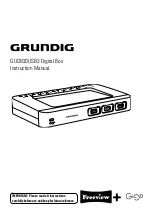
EGV-40 CW QRP Transceiver
Page 28
If you have access to a RF generator, inject through the antenna header a signal on the receiving range
of about 1-2 µV, tune the receiver into it, and adjust alternately T1 and T2 until you get the maximum
signal on the headphones.
If you don't have access to instrumentation, do not worry, as these adjustments are not critical at all.
Connect an adequate antenna for 40 meters to EGV-40 and tune a strong CW signal, as stable as
possible; adjust alternately T1 and T2 until you get the best reception on the headphones.
BFO oscillator CV1
Once you have the input bandpass filter (T1-T2) adjusted, you will have to adjust the CV1 trimmer to
obtain the best CW note that suits your taste.
Although this adjustment is not very critical, it is more important that it seems at first; the signals
should sound bassy, and check also that this adjustment has an influence on the opposite
sideband suppression.
If you have access to a good counter with a sensible, high impedance input, try measuring the frequency
on pin 6 or 7 of IC2 and adjusting CV1 to measure something between 4.9140 – 4.9141 MHz.
Note: some counters are not sensible enough or present a large load, changing the oscillating frequency
and providing fake readings. You may try inserting between the counter and the pin a resistor (470 ohms
or more) or a small cal (22 pF or less) to reduce the interaction between the counter and the BFO.
REMEMBER: All transmission checks should be done with a 50 ohm load connected to
the transmitter output.
DO NOT OPERATE the transceiver without a heatsink on Q12.
Adjustment of the TX, T3 and T4 bandpass filter. Adjustment of CV4, TX shift.
Note: for this adjustment you will need a trimming tool for this kind of IF cans; if you use a screwdriver you may
break and damage the coil core.
Connect a power meter and a 50 ohm load to the antenna connector. Turn P4 (power control) to mid
position.
Connect a Morse key to the "KEY" headers and use the key to activate the transmitter (or shortcircuit the
"KEY" headers.) You will notice that the receiver mutes and a reading on the wattmeter. Adjust
alternately T3 and T4 to peak the power. With P4 on its mid position you will get some 2-2.5 W output
power.
Put the headphones on and, while on TX, listen the sidetone monitor; turn CV4 until you hear a tone that
suit your tastes. This adjustment can be done by ear, it is not critical at all, but usually the TX/RX shift
lies around 600-700 Hz.
Please notice that the EGV is receiving its own transmitted frequency: the tone you are hearing is the
same as the shift, the offset, of your transmission.
If you have access to an audio frequency meter you may check the frequency by measuring it at the
headphone output.
Notes:
- While you are doing the transmitter adjustments, it is a good idea to touch Q12 heatsink every couple
of minutes to check it is not overheating.
- If you plan to use always the same output power it is recommended to replace P4 with two fixed
resistors of a similar value that the ones measured on P4 at the desired power.
Содержание EGV-40
Страница 13: ...EGV 40 CW QRP Transceiver Page 13 LOCATION MAP...
Страница 34: ...EGV 40 CW QRP Transceiver Page 34 SCHEMATICS...








































